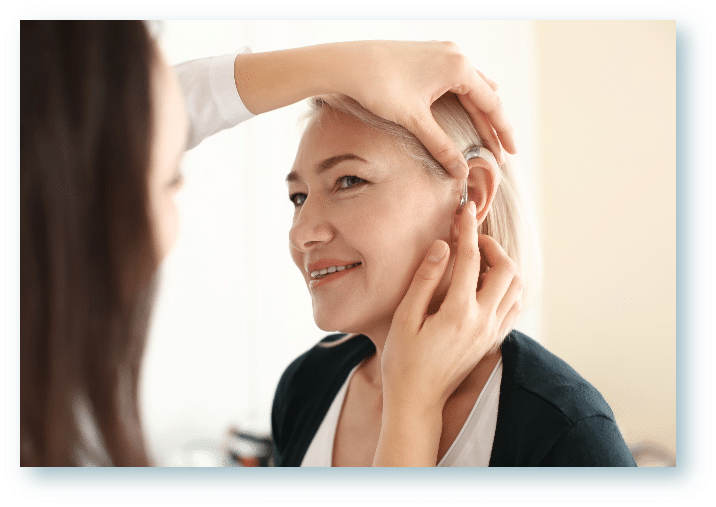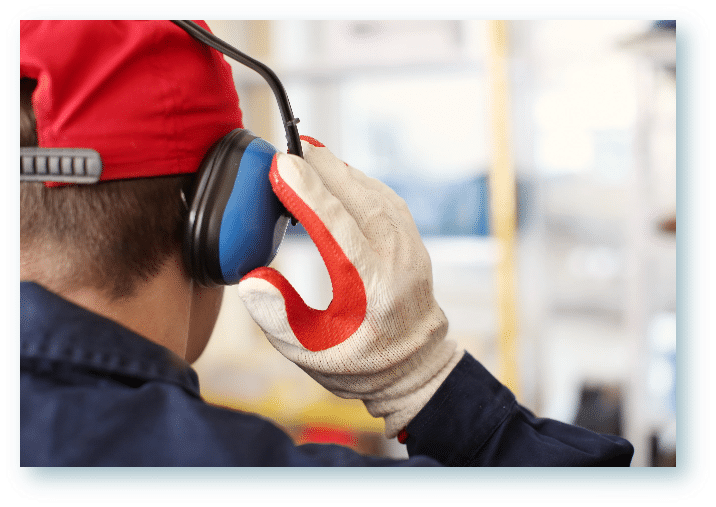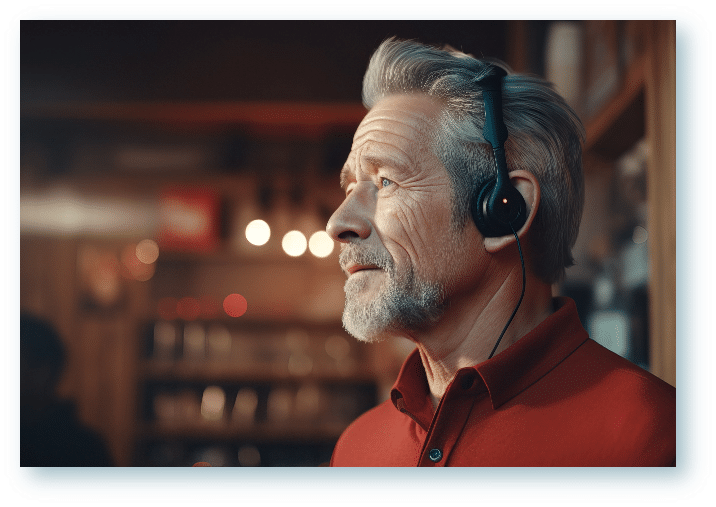
Hearing Tests in Oregon
Studies show that managing hearing loss early is the best chance of mitigating the long-term health effects that hearing loss can lead to. A hearing test is an evaluation of your ability to hear various sounds in noisy settings and how well you can understand speech. The purpose is to help you determine the degree of hearing loss you may have so we can help you find the best solution to managing it.
We offer hearing tests in Redmond and Salem, OR, for adults of all ages. The hearing test itself is quick and painless. You will sit inside a soundproof booth and listen for a series of sounds that vary in volume and frequency. The results of your hearing test will be recorded on an audiogram, which our hearing specialist will go over in detail with you.
If it has been awhile since you’ve last had your hearing examined, or you have noticed a change in your hearing ability, contact us today to schedule an appointment.
Hearing Aid Fittings
At Oregon Hearing Centers, we can expertly fit and program hearing aids to your exact needs. When you select a hearing device, we will fit the aid to your unique ear shape. Hearing aids should fit comfortably yet securely in or around your ear. Depending on the style of hearing aid you choose, we can also create custom fit earmolds for the devices, so you can ensure the perfect fit.
After your hearing aids have been custom fit to you, then our hearing specialist will program them based on the results of your audiogram. Hearing aids need to be programmed to provide you with the right amount of amplification. Because we are an independent hearing clinic, we can program any brand of hearing aid.



Hearing Aid Repairs
Hearing aids are incredibly durable and versatile. However, sometimes a problem arises that requires your hearing aids to be repaired. If you’re having trouble with your hearing aid(s), there are a few remedies you can try before bringing them in.
- Replace the battery if necessary
- Make sure the hearing aid is clean
- Change the wax filter
- Open the battery compartment and close it
- Make sure the volume and input settings are correct
Some problems with your hearing aids can be resolved at home, but if these fixes do not resolve your problem, then you should bring your devices in. Our hearing specialist is an expert in hearing aid technology and can fix almost any issue. Some minor repairs may be made on the spot, while others will need to be sent to the manufacturer for further work.
In addition to hearing aid repairs, we also offer professional cleaning services to keep your hearing aids performing their best. We recommend bringing your devices in every six months to be deep cleaned. This will ensure there is no build-up of wax or other debris in the tiny components of your hearing aids.
Custom Hearing Protection
Everyday sounds can be detrimental to hearing, that is why it is important to understand the noise level around you and how to protect your hearing ability. Hearing protection is essential for those who work in noisy environments, musicians, sports enthusiasts, motorcycle riders, hunters, and anyone who is around loud noise. Many people can benefit from hearing protection as loud noise exposure is one of the leading causes of hearing loss in individuals of all ages. At Oregon Hearing Centers, we carry a wide range of earplugs, earmolds, and in-ear monitors to keep your hearing safe. Custom hearing protection allows you to hear the sounds around you while protecting your hearing from dangerously loud noise.
Keep your ears safe by scheduling an appointment for custom hearing protection today!

Tinnitus Management
Tinnitus, commonly known as “ringing in the ears,” is a common condition affecting millions of people. Tinnitus is when you hear phantom sounds in your head or ears that are not externally present. These can present themselves as a buzzing, humming, ringing, whooshing, or whistling sound. The symptoms of tinnitus can range greatly from constant or sporadic, loud or quiet, and it can vary in pitch.
Unfortunately, there is no cure for tinnitus, but there are management options that can greatly help alleviate the perception of ringing in the ears. At Oregon Hearing Centers, we carry tinnitus masking hearing aids that will play soothing sounds in your ears, alleviating the perception of tinnitus. This form of tinnitus treatment can be helpful in distracting your brain from the phantom sounds. While hearing aids won’t stop ringing in the ears completely, they can help.

Mobile Services
We believe those who need to stay at home should have access to quality hearing healthcare. That is why we can bring our expert care to you. We provide mobile hearing services, including hearing assessments and hearing aid fittings. When you need an adjustment, remote care technology helps us to configure your hearing aids quickly and securely wherever you are.
If you are interested in our mobile hearing services, please contact us directly.
Assistive Listening Devices
Hearing aids can greatly help you hear, but sometimes they aren’t enough. When you are in a challenging environment, such as a conference room, lecture hall, or busy restaurant, you may need extra assistance to hear the person speaking. In these scenarios, an assistive listening device can be helpful.
At our hearing clinic, we carry a wide range of assistive listening devices (ALDs) that can help you hear better and with more clarity. We carry the following types of assistive listening devices for sale:
- ALDs for television use
- Infrared systems
- Amplified telephones
- Captioned phones
- FM systems
- Telecoils



VA Services
Active duty can cause permanent damage to hearing ability. Many of the veterans in our country suffer from different types of hearing problems. Returning military personnel have made countless sacrifices for our country. They often pay for it with physical injuries and long-term health problems. According to the American Hearing Loss Association, hearing loss problems are the most common service-related disease among veterans.
Oregon Hearing Centers is proud to support those who return from active service. Veterans with a service-related hearing loss condition or ear-related disorders (tinnitus) may be eligible for hearing aid services from us through the Veterans Choice Program (VCP), depending on where they reside.
If you are a veteran and plan to seek treatment from us, you must be enrolled in VA Healthcare and meet at least one of the following conditions to be eligible for VCP:
- You reside more than 40 miles from a VA Healthcare hospital
- You cannot obtain a VA appointment within 30 days of the date you want it to be
- You face an unusual or unfair burden of getting at a VA medical facility based on geographical barriers
- You have unique healthcare hearing needs which require participation in the program
- You live in a state or jurisdiction without a VA medical center that provides hearing services
Please consult with your nearest VA to see if you are qualified for hearing-related services with Oregon Hearing Centers.
Schedule Your Appointment!
Locations:
Redmond
-
850 SW 7th St.
Redmond, OR 97756 -
Monday: 8:00AM - 5:00PM
Tuesday-Friday: By Appointment - (541) 316-5299
Salem
-
2659 Commercial St. SE Suite 202
Salem, OR 97302 -
Tuesday & Wednesday:
8:00AM - 5:00PM - (503) 990-8315

